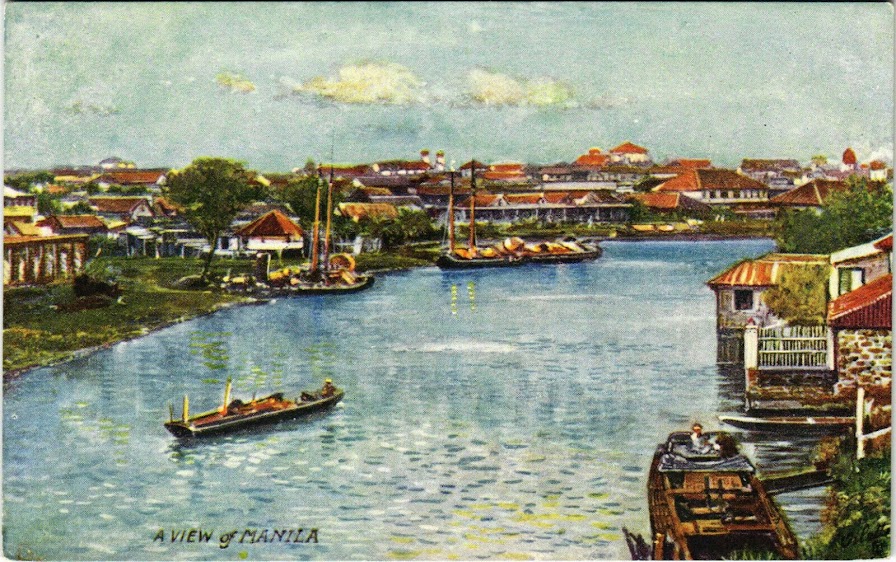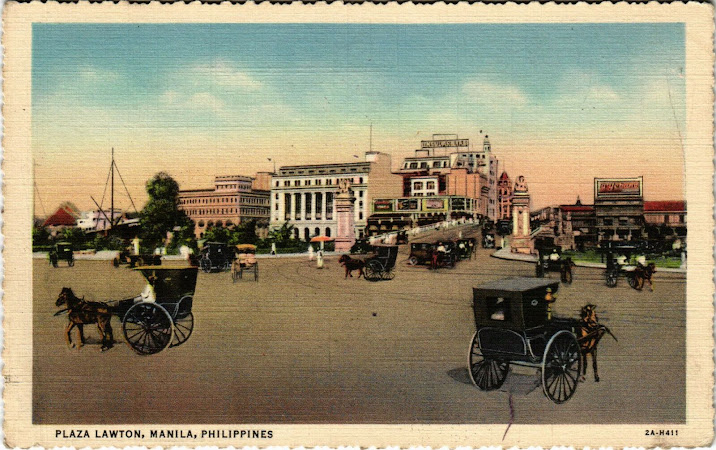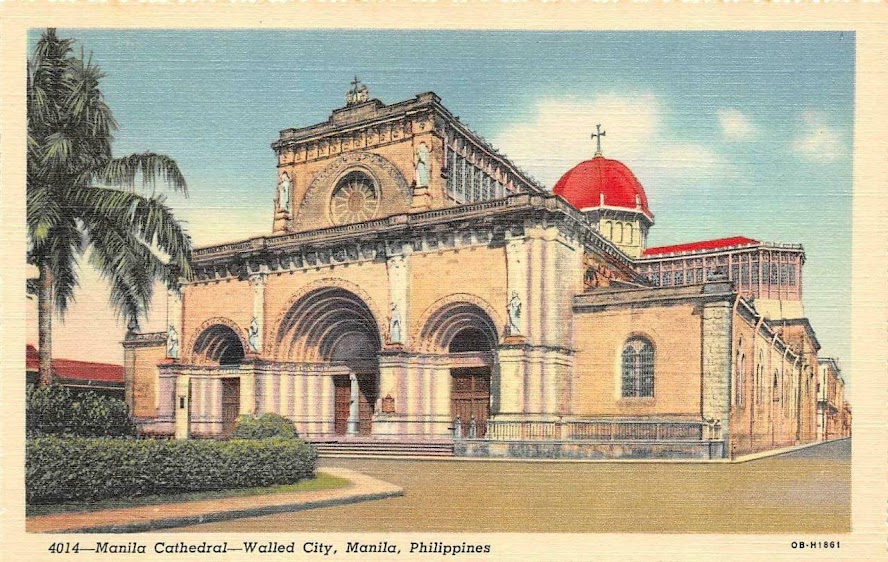The arrival of the Americans in 1898 saw the increase number of colorful postcards, these gradually replaced printed postcards during the last decade of the Spanish regime. The postcards were first printed in the United States, while other foreign postcards like French photo postcards, British painted postcards, Germany and Japanese sponsored postcards followed in the local market.

Paco River with bamboo raft
American Regime Postcards
There were at least 30 known companies which printed and distributed postcards from the early 1900 to the mid- 1950’s in the country. This does not include the Japanese sponsored postal cards which were printed during the Japanese controlled republic from 1943 to 1945.

Raphael Tuck and Son Postcard printed in England ( Suspension Bridge )
The first bridge started its construction in 1849 and was completed in January 4,1852. It used to be called Puente de Claveria (Claveria Bridge)named after the Governor General Narciso Claveria y Zaldua; who was governor-general of the Philippines from July 16, 1844 to December 26, 1849. It was built and owned by Ynchausti y Compañía.
It was built to ease the traffic going to the north side of the Pasig river which includes Binondo, Quiapo and Santa Cruz districts.
the old suspension bridge had two lanes that allow passages of horse and carabao drawn carriage during that time. It was also opened for pedestrians from Quiapo going to Intramuros and nearby areas. The total length of the bridge was 110 meters.
Its old name was Puente de Colgante, and became the first suspension bridge not only in the Philippines but in Southeast Asia as well. This was later replaced by Quezon bridge in 1939.
The suspension bridge was one of the famous landmark in Spanish and American era, Manila.

Pasig river postcard
Mr. Raphael Tuck and his wife started the business in Bishopgate in London in October 1866, The company eventually expanded into printing, distributing and featuring landmarks from all over the world.

Denniston’s Manila, Philippines ( Binondo Canal)
Denniston is one of the printer and distributor of American era postcards in the country. The code for the company Denniston Philippine Postcards with numbered “D” with at least hundreds of featured landmarks from different parts of the country.

Binondo canal with native cascos and rice
Binondo canals and Pasig river was very popular subject in many of the early postcard issuance. The river is still clean and there are native cascos which ply the river.

Quinta Market is located in the Quiapo district, It is one of the larger public market and it is still around. However the old structure was demolished few years ago to pave way for a newer public market.

Plaza Lawton or Liwasang Bonifacio during the early part of 1900 during the early part of the American administration.

Old Spanish Gate within Intramuros – This was printed by Philippine Educational Company ( PECO).

Botanic Garden– This is one of the oldest known botanic garden not just in the country but in Southeast Asia. This used to be called Jardin Botanico de Manila then changed the name to Mehan Garden.

Botanic Garden by Photo Supply Co.

Manila Central Post Office – This building is one of the first neo-classicial style built during the American regime.

Tanduay Fire Station – This fire station is another iconic landmark and still around.

Calle Palacio – This is one of the most important street in Intramuros.

Manila Cathedral – This is one of the most featured cathedral in the country.

Manila Cathedral with Pope Pius XI
This was a postcard issued sometime in commonwealth the mid- 1930’s. Pope Puis XI served from 6 February 1922 to his death in February 10, 1939.

Manila Cathedral facade

Bilibid Prison – This correctional institution is another well-known landmark in Manila.

Rotunda Fountain and Tranvia – The fountain was built in 1884 to commemorate the inauguration of Manila’s waterworks system. However, in 1976 the Rotonda de Sampaloc paved way to ease traffic congestion and was eventually moved the fountain to the MWSS office in Quezon City. Where it stayed for almost 20 years, until it was moved again in Plaza Santa Cruz in 1995 during the second term of then Mayor Alfredo S. Lim.

YMCA Building Postcard– This was the old building by Young Men’s Christian Association in Manila issued in the 1907. The old building location is near Sm Manila which is at the back of the Manila Cityhall.
According to a postcard and stamp collector, This type of postcards used to be quite common in many curio stores and even old bookstores in Metro Manila even until the mid- 1970’s.
Sources and References:
American Regime Manila Thru Postcards (part 1)
American Regime Manila Thru Postcards (part 2)
American Regime Manila Thru Postcards ( part 3)
Collins English Dictionary : Postal Card
Littrell, Robert, Ed; Postal Cards of Spanish Colonial Cuba, Philippines, Puerto Rico, UPSS, 2010.
Personal interview from postcard collectors
Philippine Postcards page 130 to 137 Consuming Passions
Philippine Postcards.com: https://www.philippinepostcards.com/
Puente Colgante. ( 2005). In Virgilio Almario ( Ed.), Sagisag Kultura ( Vol 1). Manila: National Commission for Culture and the Arts.
Filed under: Food, Place, postcards | Tagged: Binondo Canal, Manila, Manila Cathedral, Plaza Lawton, Pope Puis XI, postcards, Quinta Market, Raphael Tuck and Son, Suspension Bridge, YMCA, Ynchausti y Compañía, Young Men's Christian Association | 7 Comments »






